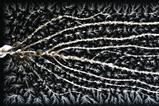An iron-rich mineral coats the serrated edges of Komodo dragon teeth, new research shows. It suggests that iron sequestration is likely prevalent in many reptile enamels but is more concentrated in Komodo dragons to maintain their sharpness.
Komodo dragons have blade-like teeth with tiny serrations along their front and back, and a thin veneer of hard enamel. Known as ziphodont teeth, they’re a characteristic that has evolved in several species, including theropod dinosaurs. Such commonality indicates that alongside their thinness, another factor makes ziphodont teeth especially effective for tearing up prey.
Now, a team surrounding Aaron LeBlanc of Kings College London in the UK has studied the orange pigmentation of ziphodont teeth in Komodo dragons. By comparing teeth samples with reference materials, they discovered that the orange iron layer is composed of ferrihydrite. This layer decelerates wear in the serrated enamel compared with other regions of these teeth. Moreover, scanning electron microscope images signal that the iron layer provides resistance against digestive acids, maintaining the teeth’s’ sharp edges.
Having to rely on fossils limits research into structure–function relationships in the evolution of dental tissues in extinct reptiles. Komodo dragons, however, can serve as a modern proxy for many aspects of dinosaur biology.
References
A R H LeBlanc et al, Nat. Ecol. Evol., 2024, DOI: 10.1038/s41559-024-02477-7









 User Center
User Center My Training Class
My Training Class Feedback
Feedback













Comments
Something to say?
Log in or Sign up for free